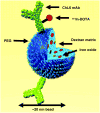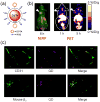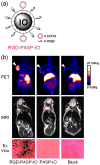Molecular imaging and therapy of cancer with radiolabeled nanoparticles
- PMID: 20161038
- PMCID: PMC2753977
- DOI: 10.1016/j.nantod.2009.07.001
Molecular imaging and therapy of cancer with radiolabeled nanoparticles
Abstract
This review summarizes the current state-of-the-art of radiolabeled nanoparticles for molecular imaging and internal radiotherapy applications targeting cancer. With the capacity to provide enormous flexibility, radiolabeled nanoparticles have the potential to profoundly impact disease diagnosis and patient management in the near future. Currently, the major challenges facing the research on radiolabeled nanoparticles are desirable (tumor) targeting efficacy, robust chemistry for both radionuclide encapsulation/incorporation and targeting ligand conjugation, favorable safety profile, as well as certain commercial and regulatory hurdles.
Figures






Similar articles
-
Radiolabeled inorganic nanoparticles for positron emission tomography imaging of cancer: an overview.Q J Nucl Med Mol Imaging. 2017 Jun;61(2):181-204. doi: 10.23736/S1824-4785.17.02969-7. Epub 2017 Jan 26. Q J Nucl Med Mol Imaging. 2017. PMID: 28124549 Free PMC article. Review.
-
Radiolabeled nanoparticles for multimodality tumor imaging.Theranostics. 2014 Jan 24;4(3):290-306. doi: 10.7150/thno.7341. eCollection 2014. Theranostics. 2014. PMID: 24505237 Free PMC article. Review.
-
Radiolabeling Silica-Based Nanoparticles via Coordination Chemistry: Basic Principles, Strategies, and Applications.Acc Chem Res. 2018 Mar 20;51(3):778-788. doi: 10.1021/acs.accounts.7b00635. Epub 2018 Feb 28. Acc Chem Res. 2018. PMID: 29489335 Free PMC article. Review.
-
Positron emission tomography imaging using radiolabeled inorganic nanomaterials.Acc Chem Res. 2015 Feb 17;48(2):286-94. doi: 10.1021/ar500362y. Epub 2015 Jan 30. Acc Chem Res. 2015. PMID: 25635467 Free PMC article. Review.
-
Exploring innovative strides in radiolabeled nanoparticle progress for multimodality cancer imaging and theranostic applications.Cancer Imaging. 2024 Sep 20;24(1):127. doi: 10.1186/s40644-024-00762-z. Cancer Imaging. 2024. PMID: 39304961 Free PMC article. Review.
Cited by
-
Nanoparticles labeled with positron emitting nuclides: advantages, methods, and applications.Bioconjug Chem. 2012 Apr 18;23(4):671-82. doi: 10.1021/bc200264c. Epub 2012 Feb 6. Bioconjug Chem. 2012. PMID: 22242601 Free PMC article. Review.
-
Pharmacokinetic issues of imaging with nanoparticles: focusing on carbon nanotubes and quantum dots.Mol Imaging Biol. 2013 Oct;15(5):507-20. doi: 10.1007/s11307-013-0648-5. Mol Imaging Biol. 2013. PMID: 23715931 Free PMC article. Review.
-
Positron emission tomography and nanotechnology: A dynamic duo for cancer theranostics.Adv Drug Deliv Rev. 2017 Apr;113:157-176. doi: 10.1016/j.addr.2016.08.001. Epub 2016 Aug 9. Adv Drug Deliv Rev. 2017. PMID: 27521055 Free PMC article. Review.
-
Biomedical applications of zinc oxide nanomaterials.Curr Mol Med. 2013 Dec;13(10):1633-45. doi: 10.2174/1566524013666131111130058. Curr Mol Med. 2013. PMID: 24206130 Free PMC article. Review.
-
Synthesis and biomedical applications of copper sulfide nanoparticles: from sensors to theranostics.Small. 2014 Feb 26;10(4):631-45. doi: 10.1002/smll.201301174. Epub 2013 Sep 19. Small. 2014. PMID: 24106015 Free PMC article. Review.
References
Grants and funding
LinkOut - more resources
Full Text Sources
Other Literature Sources
